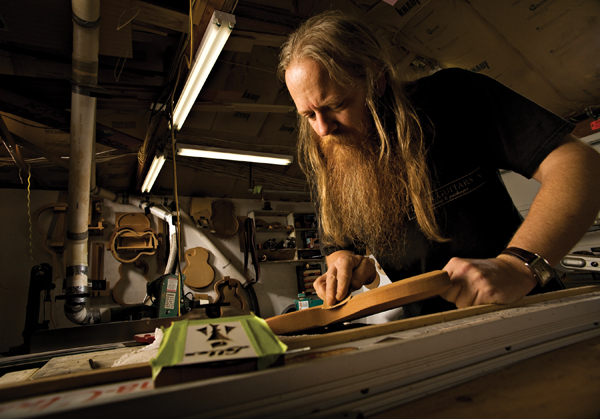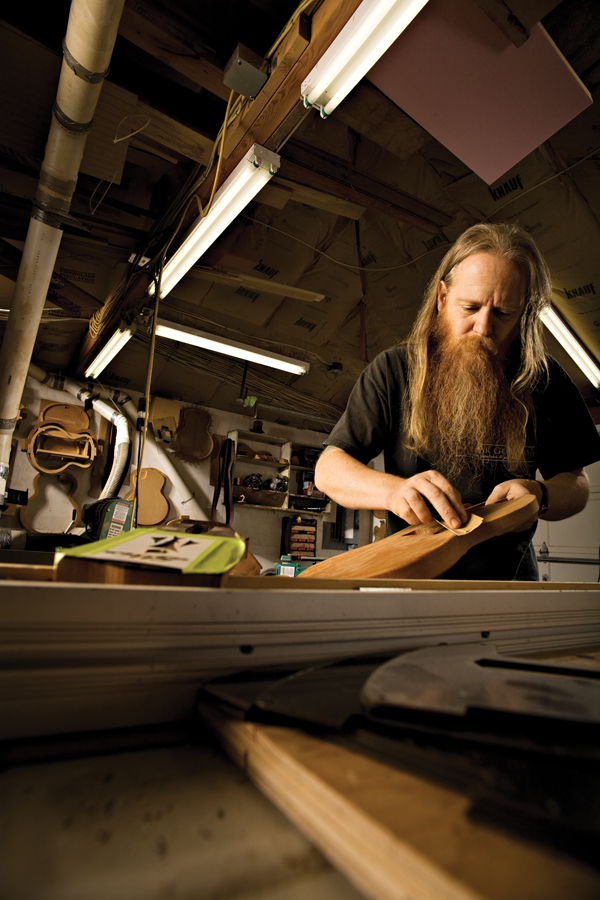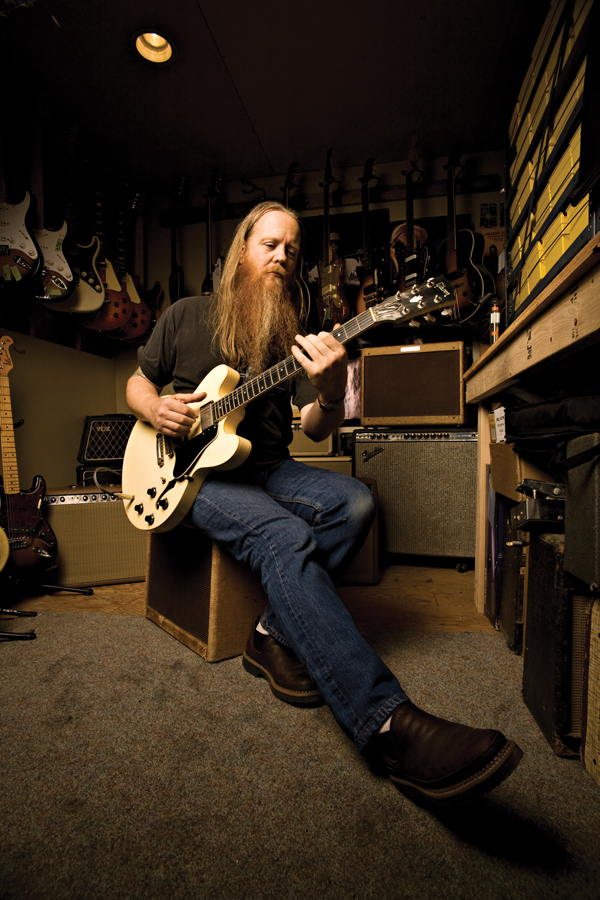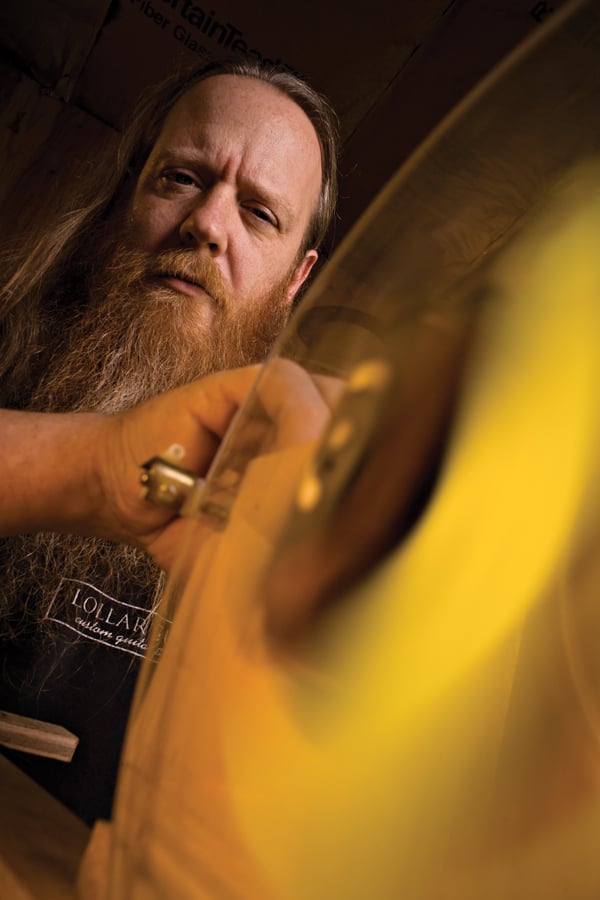Jason Lollar is one of the undisputed heavyweights when it comes to the guitar pickup market – just ask any tonehound or axe-slinger and you’ll likely get these three names: Duncan, Fralin and Lollar. His designs can be found pre-installed in some of the top guitar brands in the world, as well as in thousands of instruments as aftermarket upgrades. Lollar got his start on an old Kay acoustic at age 7, moved to electric at 11 and wound up playing professionally in bars while still a minor – performing live up to six nights per week, 50 weeks out of the year.

The master luthier and pickup guru began learning his craft at the Roberto-Venn School of Luthiery in 1979, at a time when not many people were making pickups and Stewart-MacDonald was just a banjo parts supply company with a 10-page catalog!
As he states: “I was making pickups for the guitars I built and I did occasional pickup repairs. What led me to focus so much on pickups was that I was looking for a way to broaden my customer base so that I could get enough sales to support myself building and repairing guitars without having to work other jobs. I got really serious about making it happen in the early ’90s.”
Lollar continues, “I wrote and self- published a book dealing with all of the mechanical aspects of pickup-making…and all of a sudden people were asking me to build them specialized pickups and to repair vintage pickups going all the way back to the ’30s. I wound up selling several thousand books, hundreds of people got their start in the business by following the instructions in the book and because of the new demand, dozens of suppliers eventually began selling pickup making parts.” Our interview picks up there…
How do pickups actually work, and what makes one pickup stand out against another similarly designed pickup?
A traditional electric guitar pickup is made of two or three basic components – a magnet or several magnets with a coil of wire wrapped around them, or a magnet or two and some kind of steel to make a pole piece with and a coil of wire wrapped around the steel pole or poles. The coil wire is actually called “magnet wire” and it is typically a very fine single strand of copper wire about the thickness of a hair that has an electrically insulating coating applied to it. On a typical Strat pickup, the pole piece that sits under each string is a magnet and then magnet wire is wound turn after turn around all of the magnets as a group. On a humbucking pickup the pole piece under the string is a piece of steel rod or a steel screw and the magnet sits under the coil. The difference is on a Fender pickup the magnets are in the coil and on a typical Gibson pickup there is a steel pole piece in the coil, and the magnet is under the coil touching the steel pole piece.
The magnetic field runs through the coil; when the string moves it disturbs the magnetic field, which induces an electrical current to flow that basically matches the frequency the string is moving at. The more turns of wire in the coil, the more electrical signal the coil can produce. In general but not always, a pickup with a higher DC resistance than another will have a little more output compared to the lower DC resistance. It’s like this: more resistance equals a longer length of wire (for our purposes now), longer wire length means more turns around the magnets or magnet. More turns usually means more output. Turn count can also affect the tonal qualities along with the output. More turns tends to create a pickup with more bass and or mids and less treble, also the attack can seem smoother; fewer turns can be brighter and clearer sounding overall with a snappier feel to the attack.
Oddly, a pickup that is brighter with less output than another can seem like it’s hotter than it is because of its tendency to cut through a mix better and its snappy and punchy attack can lead you to perceive something different than what’s actually occurring. Another aspect of resultant tone is the height of the coil. A Strat coil 1/32” taller than another Strat coil wound with the same amount of turns will sound a little brighter than the slightly shorter coil.
Magnets – a common magnet used in guitar pickups is called Alnico, this means Aluminum Nickel and Cobalt. Changing the amount of the various component metals will make the magnet weaker or stronger when it is magnetized. Using a stronger magnet is similar to having more wire added – basically you’ll get more signal with a stronger magnet.
What, from a technical standpoint, makes a lousy pickup sound bad?
I am fairly sure some of the cheapest import pickups are never critically listened to. I have made enough different designs to know your first try is rarely the best-sounding attempt.
Typically you build it, listen to it, critique it, make changes and try something else. If you repeat this enough times, you come up with something special.
Bad sounding pickups could also be due to inconsistent product. Even if you listen to your product and come up with a specification set that you like, if you don’t know or care what the variables involved are then one pickup could sound very different than the next. There are many things you can change in an attempt to push some aspect of tone in a particular direction. Certainly not everyone bothers with it.
Is there a certain skill or process in winding that can affect the tone of a pickup, or is it more trial and error to achieve certain sounds?
Yes – it’s called Voodoo! Pickup humor again…There is far too much BS claimed, in my opinion. First, there is no handbook to tell you if you do XYZ you will wind up with 123. Of course there is my book, but it doesn’t give specific formulas, instead it shows all the steps involved in making a pickup from scratch and how to set up a machine to wind and how to run it. You have to learn by trial and error. Let me qualify that there are some charts of turn counts of various pickups that you can find…but the majority of the specs are nowhere near correct; it appears to be something that’s been copied over and over and handed down and passed around.
Let’s say you are attempting to make an exact copy of another pickup. Even if you have the various metals analyzed and you use the same type of coil wire and get the resistance and the inductance measurement the same (measured in henries), it doesn’t mean the two pickups will sound identical. The skill involved is knowing enough to make a reasonable prediction of the results, and also to know what you can do to take the design further.
The other part of winding skill is just purely mechanical; I have seen a lot of sloppy work in photos in advertisements! With someone who is really good at it, it’s kind of like watching a great blues player; they make it look so easy and it seems simple enough that people often say, “I could do that,” but then they get up there fall flat on their face.
If someone were interested in winding their own pickups, or learning to custom wire guitars, what would be some good starting points?
If you go on the Internet there are a lot of people who don’t know what they are talking about, so take at least half of it or more as suspect information. The first thing I would do is a Google image search on “pickup winding machines.” There are photos of hundreds of different machines people have made. They can be from winding on a hand drill to elaborate self-feeding machine assemblies. You have to have something to wind with.
Secondly, I can give you a hint about a common misconception and that is the spool of wire you use to supply the bobbin does not spin; you don’t have to figure out how to make a ten pound spool spin around at the same rate as the bobbin because the wire is just pulled off the end of the spool.
The best book I have seen so far is called The Guitar Pickup Handbook by Dave Hunter. It has an overview of how pickups work, they examine various models of pickups and at the end has several interviews with pickup makers like Seymour Duncan, Lindy Fralin and myself.
I feel this is the most up-to-date and most accurate book [on the market]. Of course my book Basic Pickup Winding & Complete Guide to Making Your Own Pickup Winder will save you a lot of time and headaches; it’s still the only book out there dealing with the mechanics of assembling bobbins, winding them and finishing off guitar pickups.
Do you have any recommendations on aftermarket pickup selection for users who are new to aftermarket mods?
Learn to play first, then spend some time with your guitar “as is” so you can critique the set up. This way you’ll have an idea of which way you want to go with your tone. Use the amp you will be playing the most while you do this –
it does no good to change to a particular pickup then run out and buy a radically different amp.
Make an attempt to educate yourself a little by reading magazines and books, also watch some YouTube videos and talk to other people you know who’ve tried various pickups. It may be as simple as trying a buddy’s rig that has a particular set of pickups installed that knock you out.
If you need extra help, find a [store] that is willing to take a little time to advise you. Be prepared before you call; be specific about the guitar you have, the style of pickup it uses and the amp you’re running. You’ll need to decide some basic things: do you want more or less output? Do you want more or less bass, treble or midrange? Do you want a tighter, punchier tone or a smoother attack and more sustain? Whoever you contact can take all this into consideration and should be able to guide you in the right direction.
One more thing – get a good guitar cable; it makes a lot of difference (particularly when you use the volume and tone controls on the guitar). With good cables and good pickups you shouldn’t be having a problem loosing too much high end when you roll down the guitar’s volume knob.
Do you wind by hand or machine?
To clarify, no one would wind 10,000 turns of hair-thin wire that is easily broken – let alone keeping track of the turn count- onto a guitar pickup by hand. The “hand winding” people refer to is whether you guide the wire onto the bobbin by hand or if you have an automatic wire feed that runs the coil wire back and forth onto the bobbin for you. I use both methods depending on what I am trying to do, and even the auto winders I do use were designed back in the 1940s or possibly the 1930s. The auto winders I use are set up so they have a lot more randomness to each layer of wire, which mimics hand-winding to a large extent.
The technology that these machines use to guide the wire is actually from knitting machines invented in the 1800s. There is a misperception that an auto-fed winding machine layers each turn of wire next to the last in an orderly fashion. This pattern of wire placement is claimed by some to kill tone. Maybe it could if the machines actually did that, but in practice- because of the unique shape of guitar pickups – even a computer-programmable winder is going to have variation from one turn to the next.
How many pickups does your shop produce in a given day, week, month?
Right now we have nine people who work in the manufacturing part of the shop, which includes the shop foreman and myself. Between all of us, we can make up to a couple thousand pickups a month, and have been for years. I have overseen the making of tens of thousands of pickups, if not more, and I have personally made thousands, if not more!
For the love of God, why is it so hard for manufacturers (besides yourself) to make a decent Jazzmaster pickup?
If you look at the side view of a Jazzmaster pickup, you would notice the coil height is only slightly taller than 1/8”. A Strat pickup would have a coil height closer to 1/2” tall. Imagine what happens to the width of the coil when you have a short space to wind 8,000 turns on it – it makes the width much wider than a taller coil, which would be narrower for the same amount of turns. Looking at the top view of a Jazzmaster pickup, where you would see the entire pickguard, you get a coil almost 1-1/2″ wide by 3-1/2″ long, where on a Strat it would be more like 5/8” by 2-3/4”. Obviously, this is much narrower than a Jazzmaster. These short coils are a lot harder to make for several reasons, one being it’s much harder to control the tension on the coil, which can warp the bobbin much easier than on a Strat coil. And if you make a mistake and have to cut the coil wire back off the bobbin, you only have 1/8” clearance to get a knife in the coil. Stripping a Jazzmaster pickup if a mistake is made takes way more time than usual, and they are extremely fussy about wire tension. Too much wire on a Jazzmaster pickup will quickly make the bass response too loose and flabby. It’s certainly not the hardest to make, but it’s easy to mess up.
Are there any final words of wisdom for either new custom builders, or guitarists looking to upgrade their instrument?
Take your time and research what it is you are after before you go throwing money at it. Best way to check the credentials of whoever you have do the work is to ask guitar makers who use that company’s products, rather than relying on what you read on Internet forums. Forums have a terrible habit: when you ask about one [shop’s work], all of a sudden you get 20 different [manufacturer] names and no one has commented on the original shop in question.
Another way is to see if you have a pal that own examples of what you want to try; maybe there is a local store that sells them or maybe they have guitars that come stock with the particular pickup. Talk to the guy behind the counter selling them and talk to the guy installing them, because you’ll hear about the product from two different angles.
photos by Rick Dahms



